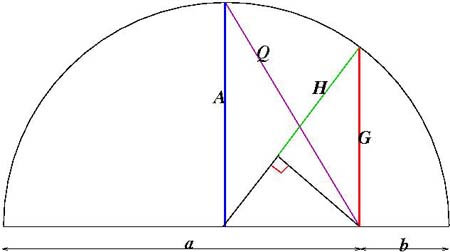Copyright © University of Cambridge. All rights reserved.
'Classical Means' printed from https://nrich.maths.org/
Show menu
For any two numbers $a$ and $b$ three classical Pythagorean means are defined, the arithmetic mean $A$, the geometric mean $G$ and the harmonic mean $H$ such that:
$$\eqalign{
A &= \frac{1}{2}(a+b) \cr
G &= \sqrt {ab}\cr
H &= \frac{2}{\frac{1}{a}+\frac{1}{b}}.}$$
(i) Prove that $H=\frac{G^2}{A}$.
 |
(ii) In this diagram the semicircle has diameter $a+b$. Prove
that the lengths $A$, $G$ and $H$ (shown in blue, red and green)
are equal to the three means and deduce from the diagram the
inequality
$$A> G> H.$$
|
(iii) Prove from the diagram that the length $Q$ is equal to the quadratic mean (or root mean square) such that $$Q=\sqrt{\frac {a^2+b^2}{2}}.$$